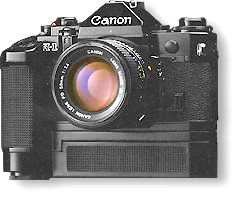The metering
system used in the Canon A-1
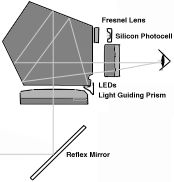 |
|
Location of the SPC (Silicon Photo Cell) in the prism to measure subject brighness based on center-weighted average pattern. Illustration also shown location of the LED panel. |
Since the SPC is located some near
the eyepiece, the Canon A-1 also provides a very considerate eyepiece shutter for
closing the eyepiece in self-timer or remote operation - Since the A-1's metering
system is not real time OTF (Off the film plane type).Any strong light source from
the back may affect accuracy of the metering cell in automatic exposure mode. Since
the Canon A-1 is essentially an electronic AE SLR camera, the metering system must
be both precise and sensitive to handle the enormous task of computation. For the
former, Canon designed a new analog-to-digital converter for the A-1. It changes
metering information from analog form to digital form, thus integrating exposure
metering into the pulse control system and making it extremely accurate. For the
latter, a silicon photocell or SPC, is used and placed just above the viewfinder
eyepiece, the SPC has superior linear and response characteristics to detect even
minor changes in light. And to protect the SPC from being affected by temperature
and humidity changes or external electric disturbances, it has been sealed together
with a logarithmic amplifier having an IC for discharge circuitry. A-1's metering
system is using a popular center-weighted average metering system (Canon called it
as 'Central Emphasis Averaging Metering' method). With this system, the entire viewing
area is read, but places more emphasis on the center portion as that is most likely
to be where your subject is placed.
 |
But because skylight often affects the metering causing your picture to be underexposed, this weighted center portion is located just below the center line of thc viewfinder, thus minimizing this effect. |
Wide Metering Range: The
A-1 can meter even in very dim light. Its range is in 21 steps from EV 18 (f/ 16,
1/1000 sec.) down to EV-2 (f/1.4, 8 sec.). The latter exposure value represents the
minimum light level at which you can still see and focus your subject through the
viewfinder. Not impressive ? Pehaps you are using a modern yardstick to measure,
but that was indeed a very impressive performance for a SLR camera to go down to
- EV2 in its metering range. Generally, more commonly is between EV 1 to EV 18.
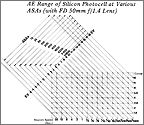 |
AE Range of Silicon Photocell at Various ASAs (with FD 50mm f/1.4 Lens) Programmed Combinations of Shutter Speeds and Aperture in Programmed AE (with ASA 100 film) Only available in PDF Format (131k) |
How does this wide metering range
benefits ? Well, it is good for photographic applications such as photomacrography
and photomicrography in which dim light conditions are common, the A-l's metering
range will then be of great help. The A-1 has several features that has helped and
made this range so wide. First, there are 16 shutter speeds you have to choose from,
varying from 1/1000 sec.
to a low range of 30 seconds
! With a selection like this, at least for slower-range shutter speeds, there is
a possible speed to cover any light condition the meter can read. A second feature
involved is the ASA of the film used. The A-1 again exels here - the ASA Dial has
an incredible wide range of settings for ASAs from as
low as 6 and as high as 12,880 with calibrated markings in 1/3 increments ! All films currently available as well
as any to be designed in the future are therefore usable in this camera. However,
just like any of the SLR made prior to popularity of AUTO DX Film coding,
the A-1 still requires you to index the film speed manually.
Exposure Compensation The A-1's metering system is great for most circumstances.
There are special cases, however, that demand compensation of the exposure. For example,
the camera can be fooled when you take pictures having a lot of bright sky, sand
or snow and when taking contrejour shots. Unless more exposure is given, your photographs
will come out under-exposed. You may also want to intentionally over or underexposure
your shot. For whatever reason, the A-1 offers you two ways in addition to manual
control.
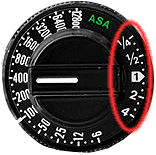 |
The Exposure Compensation Dial can be used for general compensation. Marked in 1/3 f/stop increments, the camera will automatically compensate for exposure by as much as +-2 f/stops, depending upon where you set it. But if you want more precise correction the Exposure Memory Switch is also available. |
If, for instance, you are photographing
an against-the-light subject, you can get closer to this subject, press in this switch
to lock in the proper EV, go back to where you were and take the shot. As long as
you keep the switch held in, the A-1 will expose your subject perfectly regardless
of the surrounding light conditions. Moreover, you can change either aperture or
shutter speed depending on which AE mode you are in while using this switch. The
camera automatically selects the.opposite factor to keep exposure at the same locked-in
EV.
Multiple Exposures. exposure operation on the A-1 is a real joy to use, positive
and assuring. The older way of rewind-and-guess method of taking multiple exposures
is no more with the A-1. Just sticking out from underneath the film advance lever
is the Multiple Exposure Lever. Merely slide it to the left and throw the film advance
lever. The film will stay in place and the shutter will be primed for the second
exposure.
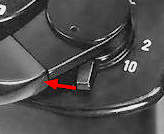 |
You can repeat this operation to your creative desire's content and the frame counter will remain fixed until you move on to the next frame. Strangely, this convenience was not used in other series A and Series T (some of which is lacking it as well). |
However, it is NOT
advisable to use with the Motor Drive MA or the Power Winder A2 in continous mode
- they will be
automatically turned off so it will not advance film.
Warning: Multiple exposure may require exposure compensation
based on the number of exposures duplicated (decreased the exposure by factors based
on the number of exposures added on the same frame).
 |
Two-Speed Electronic Self-Timer |
 |
The LED lamp to the right of the AE Mode Selector/shutter release button will blink off and on, slowly at first. Then, two seconds before shutter release, it will start blinking faster as a warning. Besides the 10-second time lag, one of two seconds is also possible. This is especially useful as a method of shutter release in place of a cable release. Can the self timer be cancelled halfway in operation ? Possible. There are two ways: either move the Main Switch to "L" or depress the Battery Check Button.
Eyepiece Shutter The Canon AE-1 introduced earlier has not provided with this feature. However, it does provide a separate clip-on shutter blind to shield light entering the eyepiece when you are in un-manned self timer operation or remote photography. |
The Minolta XD-7 perfected that with a built-in eyepiece shutter, so does the A-1 featured here which introduced a year later in later in 1977. When the lever to the left of the eyepiece is flicked, the eyepiece shutter will move into place. This is helpful when taking long exposures and especially useful in night time photography as it will keep extraneous light from entering and affecting exposure reading. The same is true for self-timed and remote control photography.
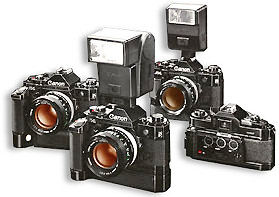 |
There are two types of automatic film advance devices designed originally for the Canon A-1. A high speed (5fps) Motor Drive MA and a 2 fps Power Winder A. However, when the Canon AE-1 Program was introduced later in 1981, it also brought along a new Power Winder A2, the A2 is also compatible with the A-1 and most of the models within the A series models. Both of these have a separate sites on their own, including the respective Instruction Manuals but here is just a short summary of these optional accessories and the usage, possible applications whwn combined with the body and also how they perform with the A-1 . |
Motor Drive MA
The Motor Drive MA is L-shaped in its layout and come with a handgrip in front on the right hand side. The bottom attaches to the camera's tripod socket just like the power winders. It is considerably heavier than the winders. One reason for this is that it requires twelve AA-batteries (Alkaline recommended) to operate. It is also possible to power it with the NC-Pack MA, which houses twelve NiCd rechargeable cells. But it is a great companion for the Canon A-1 to further enhance the camera's capabilities. The motor drive and power source in the form of battery pack to store normal alkaline cells or NiCd power pack make up the whole motor drive unit.
 |
|
Structure: Grip type, composed of a motor for film winding, an electromagnetic clutch, a set of gears and a shutter release button.
Dimensions and Weight: 151 x 67 x 80mm (5-15/16" x 2-5/8" x 3-1/8"), 200g (7 ozs.)
* More info and instruction manual for the Motor Drive MA is available in a separate section. The other unit is the Ni-Cd Pack MA. Requiring no batteries, it is therefore smaller in size than the Battery Pack MA, though the maximum speed attainable with it is only 4 fps. The Ni-Cd Pack MA is, however, rechargeable and lasts longer in lower temperatures.
Option of variety of operating speeds. Not only does the Motor Drive MA offer a choice of power sources, there are a variety of shooting speeds as well. Either single-frame shooting or speeds of 3.5 fps and 5 fps can be selected. Marked "S", "L" and "H" respectively, you can change from and to the other easily by the selector dial located on both battery packs.
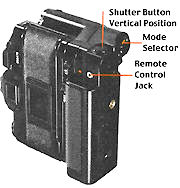 Further, the A-1 and its accompanying Motor Drive MA and power sources offer a total of three shutter release buttons. In addition to the camera's regular button and the one on the drive unit for normal, horizontal shooting, there is also one on both power source units for photography in the vertical position. |
 |
The Motor Drive MA is attached to the A-1 by aligning attachment pins on the unit with holes on the camera body. A special knob is then available for tightening. Likewise, the Battery Pack MA and Ni-Cd Pack MA are attached to the motor drive in the same way. This method is much quicker and less bothersome than the screw-type mount of other units. One other thing about this motor drive is that it automatically stops when the film reaches the end. At that time, a warning lamp on the power unit will come on. This lamp also lights up when the batteries have become exhausted. |
| There are more goodies when
you attached the Motor Drive MA onto the A-1. In case the pace of the action suddenly
steps up, there is a button makes sure you stay right with it. It locates on the
Battery Pack MA (But it is not
available on the Ni-Cd Pack MA).
The instant high-speed button will immediately switch the drive to the fastest speed,
no matter where the selector dial is set.
|
||
Ni-Cd Pack Unit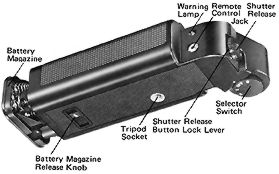 |
Structure: Consists of a motor control circuit with an automatic stop circuit, Ni-Cd battery, a vertical position shutter release button and a selector switch. |
Battery Life: (H mode with
36 exposure film) Normal Temperatures: 60 rolls or more. Low temperatures ( - 10°C):
15 rolls or more.
Power Source: Built-in Ni-Cd batteries, 14.4V. Rechargeable.
Dimensions and Weight: 151 x 61 x 29mm (5-15/16" x 2-3/8" x 1-1/8"),
205g (7 ozs.)
Battery Pack MA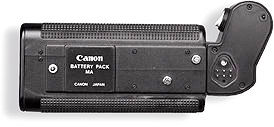 |
Structure: Consists of a motor control circuit with an automatic stop circuit, a battery magazine for penlight (size AA) batteries, a vertical position shutter release button, an instant high speed mode button and a selector switch. |
Shooting Modes: Three changeable
modes. H (5 frames/sec.), L (3.5 frames/sec.) and S (single frames).
Battery Life: (H mode with 36 exposure film) Normal Temperatures: 60 rolls
or more. Low temperatures ( - 10°C): 5 rolls or more.
Operable Temperature Range: - 10° C - + 45° C.
Power Source: 18 volts (12 penlight size AA batteries).
Dimensions and Weight: 151 x 67 x 40mm (5-15/16" x 2-5/8" x 1-9/16"),
395g (13 ozs.) including batteries.
Power Winder A2/A If you
don't require quite the high speed of the Motor Drive MA, there are two excellent
alternatives. The Power Winder A2 and A still advance the film at a brisk two frames
per second (usable shutter speed range for continuous shooting, 1/60 to 1/1000 sec
and moreover the Power Winder A2, like the Motor Drive MA, can be used with the Wireless
Controller LC-1 for remote-control photography. The Power Winder A2 has a convenient
switch for continuous/single shooting.
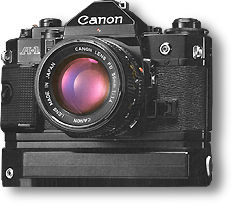 |
What are the differences between the Power Winder A and Winder A2 ? Basically, the earlier Winder A cannot operates in continuous mode because you need to remove your finger from the shutter release button before the film will advance to the next frame. The Winder A2 improved that by incorporating a choice of either Single ('S') or Continous ('C') Mode opreration. Further, it also can be used with remote cord with a new remote control socket built-in. Basically, both Winder A and A2 will work with the Canon A-1, but the speed is limited to single frame advance with the Winder A or two frames per second with the Winder A2. |
Winding Speed: About 0.5
second.
Operation: Activated by the shutter release button of the camera.
Shutter Speed Coupling Range: 1/60 to 1/1000 second for continuous photography
"B" to 1/1000 second for single frame photography.
Frame Counting: By the frame counter of the camera
Automatic Cut-off Circuit: At the time of completion of a roll of film, or
when battery power is insufficient, the Power Winder A2 automatically stops and its
LED glows.
Mounting: Attached via the tripod socket after the winder coupler cover has
been removed.
Power Source: Four penlight alkaline manganese batteries (size AA); good for
about 40 rolls of 36-exposure film under normal temperatures. Ni-Cd batteries also
usable.
Size: 140.8 x 27.5 x 53.4mm (5-9/16" x 1-1/16" x 2-1/8")
Weight: 275g (9-11/16 ozs) including batteries.
Also referred more
on the Winder A2's capability when used with some of the respective A-Series models.
If you think high speed or automated motor film advance is not your kind of photography
and thus there is no such needs in acquiring a Motor Drive or Winder, but these added
on accessories designed by Canon came with other special purpose as well. As not
to complicate the circuirty of the main body, usually other application such as remote
control is handle with any of the device attached to the body. Although this was
made part of the main feature of T series
SLR models, but as with the professional camera body of the Canon F-1,
the basic concept still remain as it was for all the A series models. Below are some
optional accessories that you can purchase separately to make your A-1 more fun to
play with. Most of these accessories can be found in the used market and virtually
all Canon A and F series SLR cameras can be shared to use with any of them.
Wireless
Controller LC-1 This accessory
consists of two devices: a transmitter and receiver. It enables wireless, remote-control
shooting, sequential or single-frame, from a distance up to 60m in a straight line.
Motor Drives MA and FN can be controlled from a distance by the hand-held LC-1 Transmitter,
which sends an infrared control signal to an LC-1 Receiver unit mounted in the camera
hot shoe for convenience, and cord connected to the Remote Control Jack on the motor
drive. To avoid interference among LC-1 systems in the same area with several photographers
that are using radio controlled units around the same area, each LC-1 can be set
to a different channel. Further, more than one LC-1 Receiver can be controlled by
the same transmitter, either all on the same channel or on different channels. With
its three channels, the LC-1 can operate up to three cameras in succession. Simultaneous
control of as many cameras as desired is also possible by placing receivers on every
camera. And since it is operated by a special light emission, it will not be affected
by light from a flash or other sources.
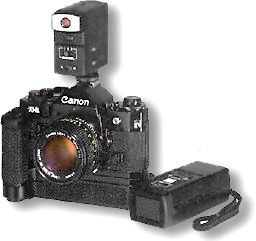 |
Transmitter: Power Source: Two penlight alkaline manganes batteries. |
| Previous | Next | 6/8
|
Back | Index
Page of Canon A-1
| Back |
Main Index
Page of Canon SLR Models
History
& Background
| Basic
Camera Operation
(14 Parts)
Main Reference
Map - HTML | PDF (270k)
Specification
- HTML | PDF (96k)
Shared Resources:
Winder A, Winder A2, Focusing Screens, Motor Drive MA, Databack A,
Speedlites & Macro photography.
Canon FD
Resources
A Series:
AE-1
| AT-1
| A-1 | AV-1
| AE-1 Program | AL-1
T- Series: T50
| T60
| T70
| T80
| T90
F-1
| New F-1
Canon FL
Resources
Pellix
| FTQL
FL | Canon FDn lenses. | Early versions of FD lenses
Highly suggestive useful external links/resources created by Mr.Christian Rollinger:
Essentials: - Canon A1 Repair/Service Guide | Determine Years of Made of your
Canon
Canon Flash models:- Canon 300TL flash(1.5MB); Macrolite ML-1(HTML); Macrolite ML-2;
Macrolite ML-3; Speedlite 133a; Speedlite 155a(HTML); Speedlite 177a; Speedlite 188a(HTML); Speedlite 199a; Speedlite 244t; Speedlite 277t (HTML); Speedlite
533; Speedlite 577
Others:- Canon Auto Bellow Unit Manual; Canon Macro Photography Guide, Canon Slide Duplicator Manual, Canon Angle Finder User's Manual
| Message Board |
for your Canon
A-Series SLR camera(s)
| Message Board | for your Canon optics
in a shared environment
| Message Board | Specifically for Dispose or Looking for Canon Photographic
Equipment
Home - Photography in Malaysia
![]()
Copyright
© 2000.
leofoo ®. MIR Web Development Team.
Maintenance
Team: Kaipin, Terry Carraway & Dr Strangelove; Pawel Nabe for his image
on the Data Memory Back. EEwyn Foo, my nephew, who
has spent quite a number of nights converting the original manual in HTML format.
Mr. Richard Yeow, General Manager
-Optical Division of Canon Marketing for granting special
permission to reproduce this manual into HTML format in his site as a form of obligation
to all Canon FD mount users worldwide.
* Canon, FD Lenses, Canon Marketing are registered
trade names or trademarks of Canon
Inc. Japan.


